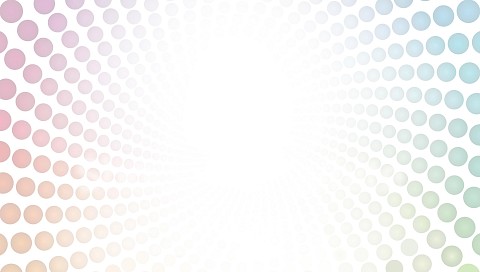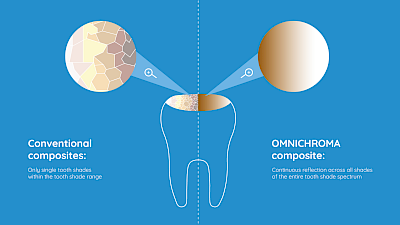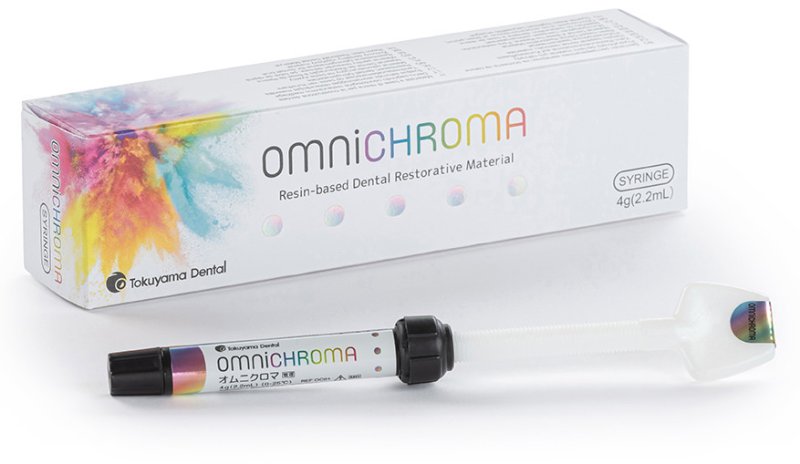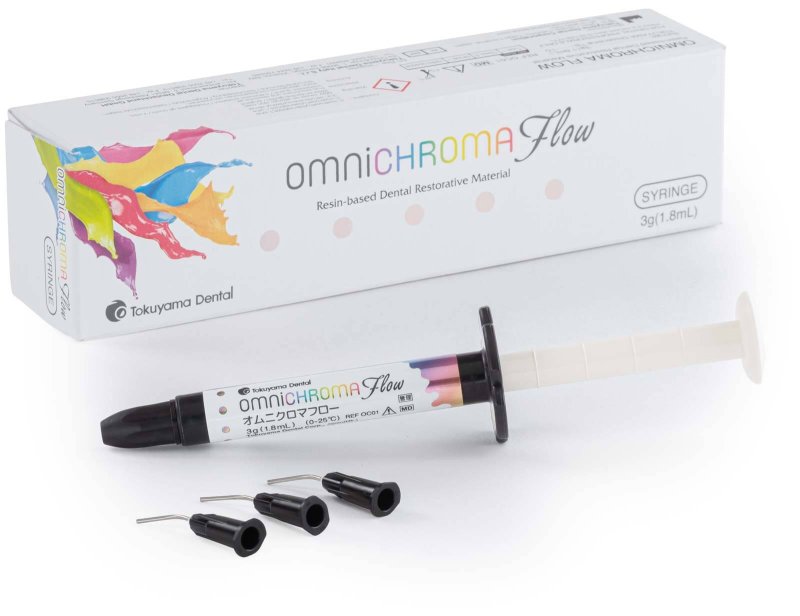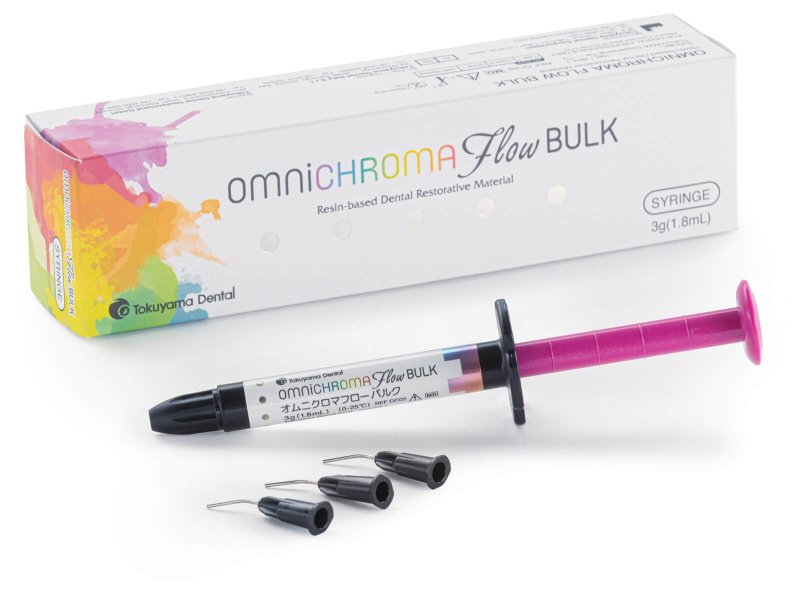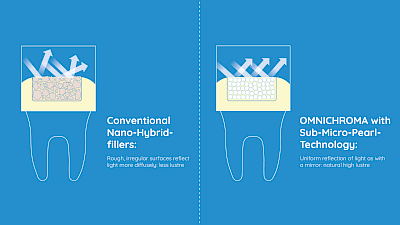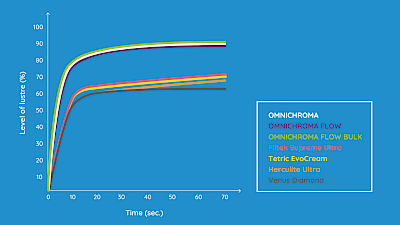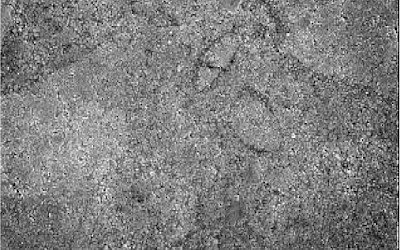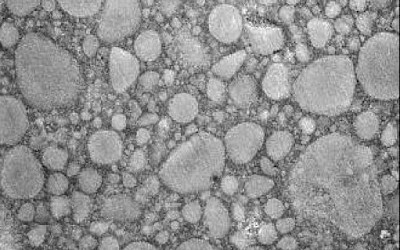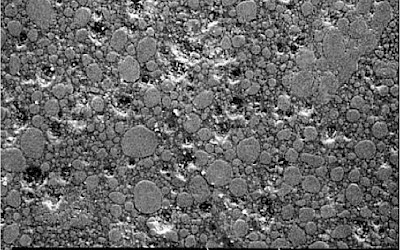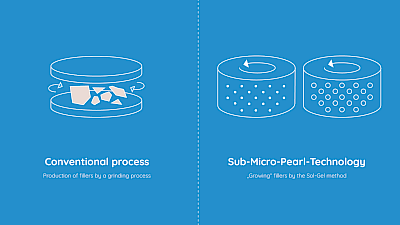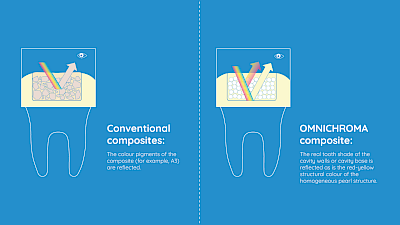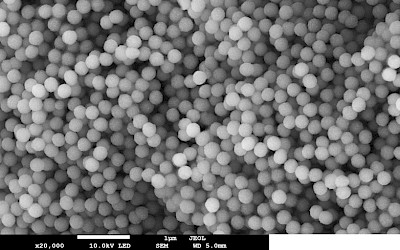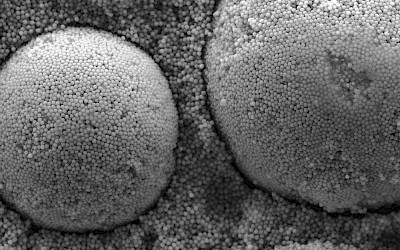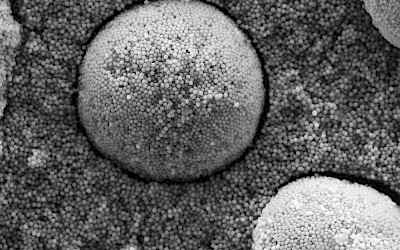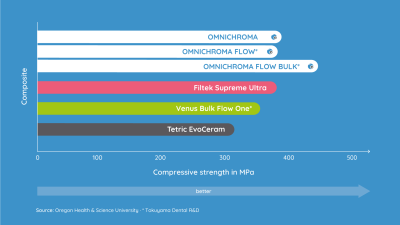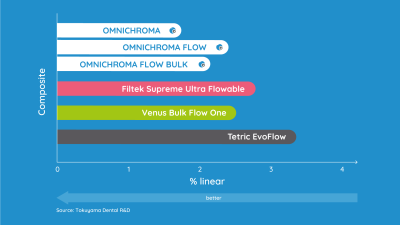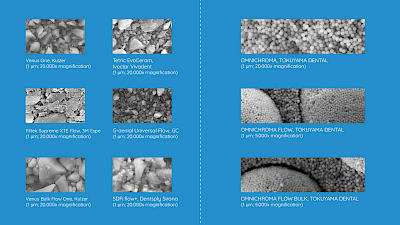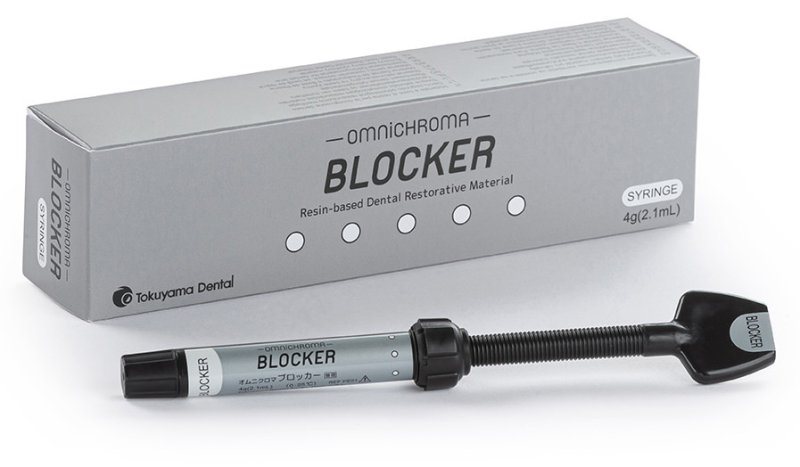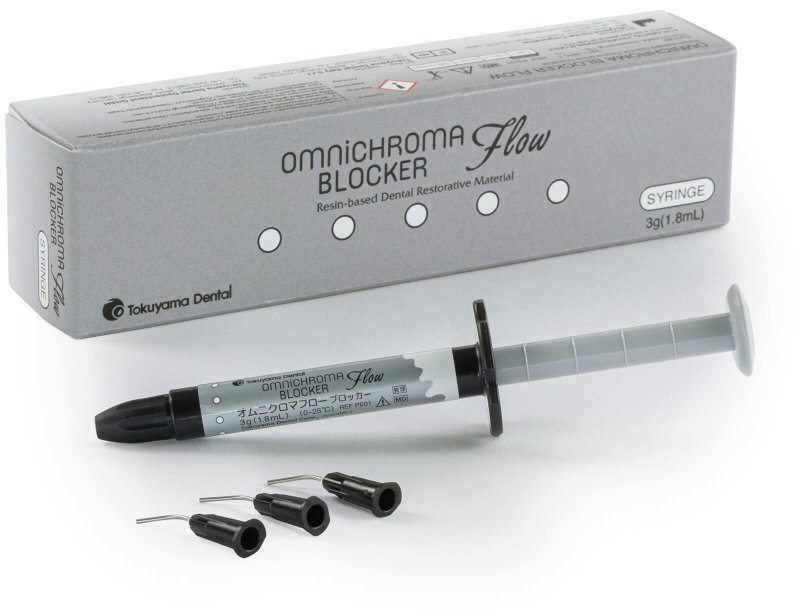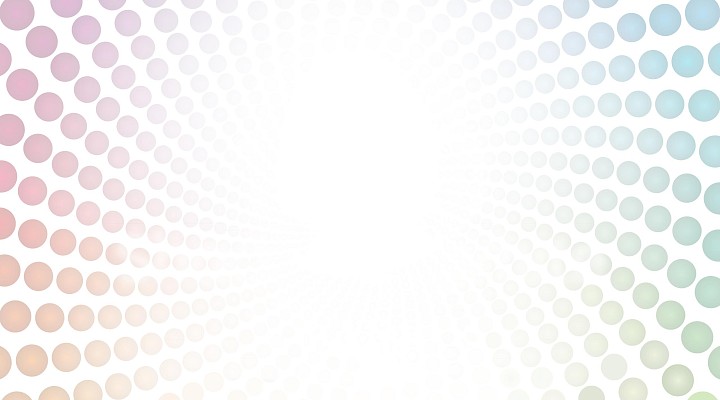
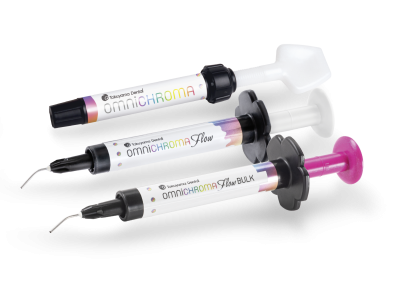
OMNICHROMA: Only a single composite for the entire range of tooth shades
With OMNICHROMA, TOKUYAMA DENTAL has achieved a decisive innovation leap in composites. For the first time, the long sought-after chameleon effect has been achieved successfully culminating in natural perfection. The reason is as simple as it is spectacular: both the OMNICHROMA and the chameleon are coloured through light and not through pigments.
Below you will find all the important information about the composite material from TOKUYAMA DENTAL.
Would you like to test OMNICHROMA? Request a free sample now!
OMNICHROMA – The Future of Composites
To activate the YouTube video, you must agree to the marketing cookies.
3 Viscosities – Infinite Possibilities
OMNICHROMA, OMNICHROMA FLOW, OMNICHROMA FLOW BULK & BLOCKER, BLOCKER FLOW
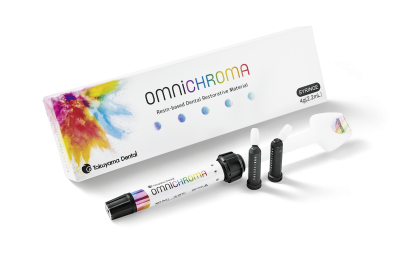
OMNICHROMA
The pasty OMNICHROMA represents a true revolution in composites. The Bis-GMA-free formulation is indicated for the anterior and posterior region and covers all classic VITA shades with only one colour.
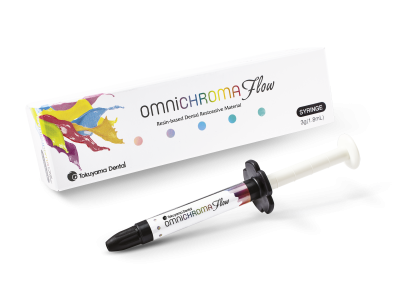
OMNICHROMA FLOW
The inimitable Smart Chromatic Technology is also available in a flowable formulation. Just like its pasty predecessor OMNICHROMA, OMNICHROMA FLOW can be used for all cavity classes. The flowable type also impresses with its infinite colour matching and outstanding resistance.
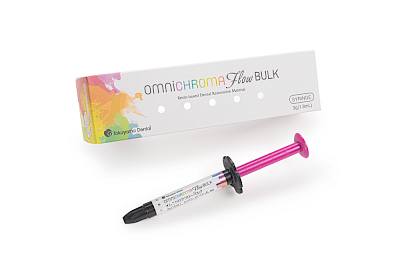
OMNICHROMA FLOW BULK
OMNICHROMA FLOW BULK is characterised by ultra-strong in-depth curing, which means that even larger cavities in the posterior region can be reliably restored even without an additional capping layer.
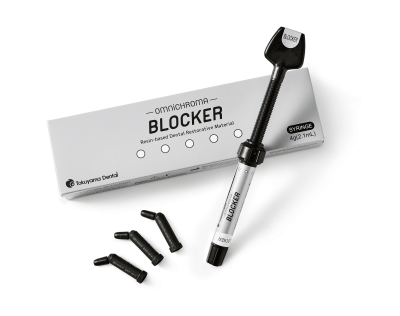
OMNICHROMA BLOCKER
OMNICHROMA BLOCKER is used as a supplement if OMNICHROMA is not to adjust to the colour of a strongly discoloured cavity or if a higher opacity is required to cover the oral cavity in the case of larger class III or IV defects.
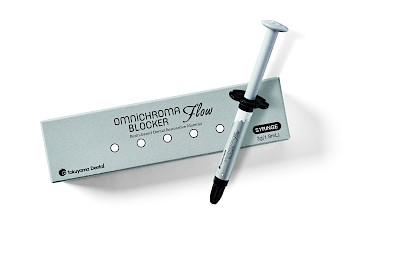
OMNICHROMA BLOCKER FLOW
OMNICHROMA BLOCKER FLOW, like OMNICHROMA BLOCKER, reliably covers unsightly discolouration and is very easy to apply and user-friendly due to its low viscosity.
OMNICHROMA: A composite with unique properties
- No sticking to instruments
- Ideal processing time
- Good visibility for processing
- Excellent adaptation to the cavity walls
- Permanent colour adjustment even after bleaching
- Perfect lustre
- Excellent colour fidelity
- Highly resistant to discolouration
- Free of Bis-GMA
- Reliable long-term restoration
- Colour matching to real tooth shade
- No time-consuming shade determination
- Simplified stocking
- Fast polishability

TOP AWARD Winner since 2020
With its annual "Top Awards", the international magazine DENTAL ADVISOR is regarded as a benchmark for independent evaluations of dental products. The OMNICHROMA composites from TOKUYAMA DENTAL have received the prestigious awards for the 5th time in a row (2020-2024).
These dentists recommend OMNICHROMA

"OMNICHROMA is GROUNDBREAKING - a win-win for all offices. No need to stock 30 composite shades that expire and take up space. So economical and it works great!"

"My first reaction was that OMNICHROMA is truly magic. The result is also beutiful, high gloss, easy to sculpt and the procedure is simple. Except for the fact that you can skip the shade selection step your workflow is the same as with regular composites. The only addition is the blocker which you can use to cover heavy discolouration which you don´t want the composite to take it´s colour from."

"A dentist‘s dream coming true: always the right colour with OMNICHROMA."

"First I was sceptical, if the colour matching of OMNICHROMA would fit. But easy application, convincing polishing results and surprisingingly good colour matching convinced me."

"OMNICHROMA is an essential composite for any restorative dentist as its colour matching after curing in circumferential enamel cavities is truly unique."

"OMNICHROMA - One colour for all fillings? Sounds completely unbelievable – but actually works!"
Colour through Light
OMNICHROMA is primarily characterised by its colour. While in conventional composites a limited number of tooth shades, e.g. from A1 to D4 according to the VITA shade system, are imitated, OMNICHROMA succeeds in covering all shades in a single composite.
Due to the “Smart Chromatic Technology”, OMNICHROMA completely dispenses with colour pigments and instead uses the natural principle of structural colour – colour that becomes visible when light strikes special structures, the same as with chameleons. The deliberate refraction of light creates structural colour in the yellow-red range and the surrounding real tooth colour is also reflected.

The Principle of Structural Colour
When pigments of a material reflect certain light waves, such as the chlorophyll of a plant the colour green, we speak of conventional "chemical colours". OMNICHROMA, however, relies on the rare, but natural principle of "structural colour". As with a prism, the shape and exact size of the spherical fillers in OMNICHROMA influence the reflection of the incident light so that only the desired light wave ranges - thus colours - are visible to the human eye.
Opaque beforehand – semi-translucent afterwards
In contrast to conventional composites, OMNICHROMA is intended to achieve an extreme colour change after curing and is also very practical when modelling. The composite from TOKUYAMA DENTAL has a white-opaque processing shade. OMNICHROMA achieves its semi-translucent shade result after just 20 seconds of curing.

Try OMNICHROMA now!
Unique Lustre
The surface of the composite is decisive for polishability and optimal light reflection. In the case of typical ground fillers, the light strikes extremely irregular surfaces that scatter the light diffusely. Accordingly, the surface appears matt and requires a long and complex polishing process to achieve a glossy result. OMNICHROMA saves you additional effort - because with its mirror-smooth surfaces, TOKUYAMA's "Sub-Micro-Pearl-Technology" ensures a quick and long-lasting lustre.
The law of reflection "angle of incidence equals angle of reflection" is the basic prerequisite for the lustre effect and only works with very smooth surfaces: mirrors, natural teeth and OMNICHROMA.
Excellent abrasion properties
OMNICHROMA is a particularly abrasion-resistant composite, yet at the same time gentle on the antagonist due to its unique filler structure, which only offers a small surface area for abrasion. In comparison, OMNICHROMA shows very low wear even after an abrasion test with 50,000 cycles (TOKUYAMA DENTAL R&D).
Composites before and after abrasion test

The Technology behind OMNICHROMA
For more than 40 years, TOKUYAMA DENTAL has been one of the leading manufacturers of innovative dental solutions. Our research and development centre in Tsukuba, around 60 km north-east of Tokyo, is a key factor in our success. Here, we have developed the "Sub-Micro-Pearl- and Smart Chromatic Technology", which form the basis for our unique OMNICHROMA composite.
Sub-Micro-Pearl-Technology
The secret of OMNICHROMA is our method of manufacture, which originates from the TOKUYAMA research centre in Japan. For conventional composites, glass materials are ground until the individual particles of the fillers lie approximately within a desired size range. However, these vary considerably in shape and size.
TOKUYAMA DENTAL uses its own entirely controlled fillers for OMNICHROMA instead and produces these fillers based on its own patented "Sub-Micro-Pearl-Technology". In this process, the Sol-Gel method is used to progressively coat spherical fillers in an organic solution. After several weeks, the fillers have "grown" evenly in a spherical shape like a pearl and are exactly 0,26 µm in size. In this optimal size, the desired colour adaptation effect is achieved precisely in combination with other outstanding physical properties.
Smart Chromatic Technology
In 2015, scientists at the University of Geneva discovered that the chameleon has a uniform network of nanocrystals in its skin that selectively reflects certain wavelengths of light. Based on this phenomenon of colour matching and through the further development of TOKUYAMA DENTAL's patented "Sub-Micro-Pearl-Technology", TOKUYAMA research has developed the "Smart Chromatic Technology" . When light strikes small spherical fillers at exactly 0.26 µm as contained in OMNICHROMA, the refraction and diffraction of the light generates the ideal red-yellow colour effect that is necessary to faithfully imitate the genuine tooth shade.
Pearl structure under the microscope
OMNICHROMA and other composites in comparison
Compressive strength
Although pasty materials are generally considered to be stronger and more resilientdue to their more solid consistency, OMNICHROMA is characterised by remarkable compressive strength in all viscosities. In a direct comparison with other composites such as Filtek Supreme Ultra, Venus Bulk Flow One or Tetric EvoCream, OMNICHROMA impresses with a particularly high compressive strength of about 400 MPa in all three viscosities.
Polymerisation shrinkage
The degree of polymerisation shrinkage is a decisive criteria for evaluating the quality of dental composites. The greater the shrinkage, the higher the demands on the adhesive system in order to avoid marginal gaps, microleakage, secondary caries or increased sensitivity. In general, pasty materials have a higher filler content than flowable composites. This results in lower polymerisation shrinkage.
OMNICHROMA impresses with minimal polymerisation shrinkage - even with the flowable OMNICHROMA FLOW BULK. For a bulk-fill composite, it has a high filler content (69% weight / 55% volume), so that the polymerisation shrinkage is only slightly higher than with pasty materials, but significantly lower than with conventional flow and bulk-fill composites.
Fillers
The fillers in OMNICHROMA are unique in their structure and composition. In all three viscosities, the fillers consist of size- and shape-controlled supra-nano particles (0.26 µm). Conventional composites, whether pasty or flowable, usually contain irregularly crushed or ground glass particles. However, control over the spherical filler particles is essential for "Smart Chromatic Technology" and the creation of structural colour - colour through light. This is because only controlled fillers enable controlled refraction of light.
Thus, OMNICHROMA offers unrivalled adaptability and aesthetics that differ fundamentally from conventional composite fillings.
Switch to OMNICHROMA now!
Studies
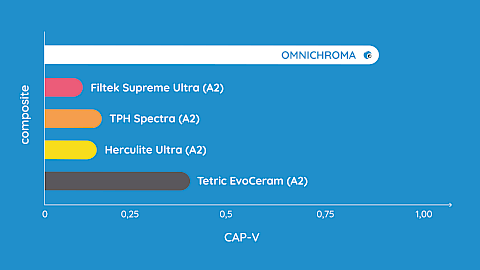
The University of Texas study analysed the Visual Colour Adjustment Potential (CAP-V) of various composite materials through visual evaluation. Of the five composites tested, OMNICHROMA from TOKUYAMA DENTAL demonstrated the best shade adaptation effect.
The evaluation of shade differences in Class I restorations compared to the surrounding artificial tooth substance was lowest for OMNICHROMA, which represented the best correlation between OMNICHROMA and the A1-D4 prosthetic teeth.
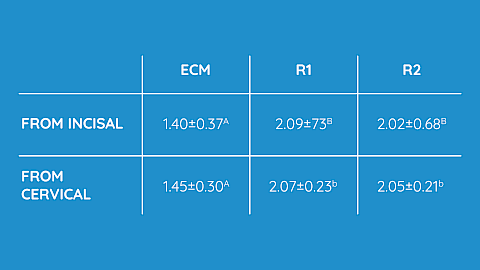
To demonstrate that the size of the fillers significantly relates to the structural shade produced, Tokyo Medical and Dental University examined three composites with fillers of different sizes for their respective shade adaptation effects. Cavities on eleven different human teeth (shades A2, A3, A4, B2, B3, B4, C2, C3, C4, D2, and D4) were filled with OMNICHROMA (0.26 µm), an experimental nano-composite (0.1 µm) and a conventional composite with ground fillers. The respective colour adaptation was then measured using a spectrophotometer and compared with the measured colour before filling (Delta E00).
The samples demonstrated significant differences with respect to Delta E00 (p < 0.05), depending on the material differences. OMNICHROMA exhibited significantly lower Delta E00-values than R1 (ground fillers) and R2 (nano fillers) from both viewed from incisal and cervical, suggesting that OMNICHROMA has a superior ability to mimic the original shade of the human tooth. This also indicates that the particle size of the filler has a significant influence on OMNICHROMA’s colour adaptation capability.
At Okayama University, a series of tests investigated the colour stability of OMNICHROMA. Four artificial teeth in the shades A1, A2, A3 and A3.5 were filled accordingly and stored in a water bath. The colour adaptation of OMNICHROMA was measured immediately after one day, after one week and after three months. The result was as follows: “The study demonstrated that OMNICHROMA can cover a wide range of cavity colours with just a single shade. This study also demonstrated that the composite material based on the structural shade system has the potential to enable esthetic restorations without shade selection or layering.”
A further in-house study (TOKUYAMA R&D) also showed that OMNICHROMA still adapts to the changed real tooth colour even after bleaching.
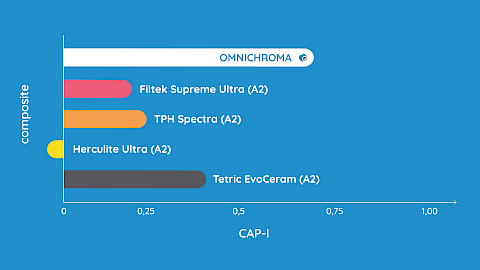
Another study by the University of Texas also analysed the Instrumental Colour Adjustment Potential (CAP-I) of various composite materials by instrumental evaluation.
OMNICHROMA again confirmed the results of the previous study (CAP-V) in the instrumental determination of the colour adaptation effect. Both visually and instrumentally, OMNICHROMA thus offers a very broad chameleon effect across the entire VITA shade palette.
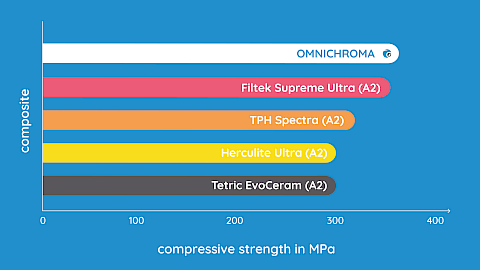
The Oregon Health & Science University investigated numerous material properties of OMNICHROMA in comparison to conventional composite materials. Here, too, OMNICHROMA’s superior class was demonstrated, as the special filler structure and filler composition result in an outstanding load-bearing capacity of the material. Among other things, this is reflected by excellent compressive strength.
Try OMNICHROMA and request a FREE SAMPLE now!
Limited to one product test per office. While stocks last.
OMNICHROMA at a glance
- Perfect colour matching
- Without artificial colour pigments
- Simplified inventory management
- Excellent adaptativity
- Non-sticky
- Good polishability
- Remarkable lustre
- Free from Bis-GMA and bisphenol A-related monomers
